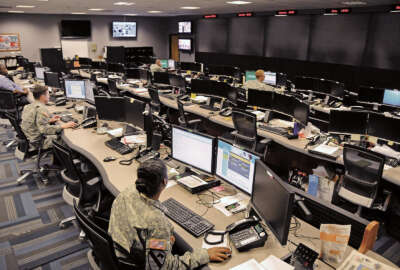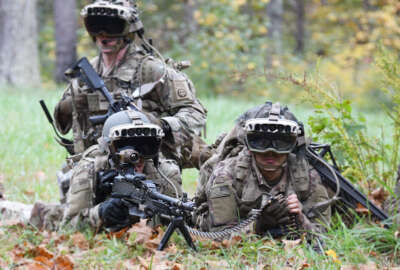Army turns to ‘jungle gym’ model to promote opportunities in the civilian workforce
Yvette Bourcicot, the principal deputy assistant secretary of the Army for Manpower and Reserve Affairs, said with 500 occupations separated into 11 career fields,...
The old days of “post and pray” to recruit employees into civilian positions in the Army is over.
Instead, the Army is moving toward a more active, and less passive, model of recruitment.

The principal deputy assistant secretary of the Army for Manpower and Reserve Affairs said the service is replacing “word of mouth” recruiting with an approach that is more targeted and understanding of the employees’ expectations for their career.
“We recognize that there is a lot of talent out there in the country that we need to be able to tap into. We need to push out the message that there are opportunities as an Army civilian, and that they should take advantage of those opportunities. Our recruiting message has modified from ‘hey, you need to come in and serve for 30 years as an Army civilian,’ which is pretty daunting to our younger workforce, to what we are now adopting, and what Dr. [Agnes] Schaefer [the assistant secretary of the Army for Manpower and Reserve Affairs] has coined this term, the ‘jungle gym’ model,” Bourcicot said on Ask the CIO. “This is where people come in and do three years in as a civilian, and then jump to something else. They go to the private sector for a couple of years, and then come back in, and then go back out and maybe start a business. They can do all different kinds of things. We’re telling people that civilian service should be a part of an overarching career path. It’s an enabling thing. It’s not an off ramp, and that we have amazing career and training opportunities for them to build skills that are that are just harder to get than in the private sector.”
The Army has about 500 occupations separated into 11 career fields that it’s trying to hire civilian employees for.
While USAJobs.gov remains a key piece to the ‘jungle gym’ recruiting effort, the Army has taken several steps to change how it approaches recruitment, starting off with a revamp of GoArmy.com by adding a “civilian workforce” tab to the military and National Guard areas of the website.
“Another thing that we’re doing is expanding our online footprint. So instead of just USAJobs, which is still the portal that people are going to use to apply, they can go to LinkedIn, and we are taking advantage of going to places where the people are by posting our jobs on platforms like Yello, in order to reach out to that cohort that doesn’t necessarily know, ‘hey, I can apply to an Army job,’” Bourcicot said. “We are going to career fairs and we are offering jobs on the spot. We’ve given offers at the Black Engineer of the Year awards, some 70 job offers there. We are updating our procedures to try and get the security clearance process going as well. So we’re really trying to make those jobs not only visible, but also accessible.”
A key piece to that visibility and accessibility is shrinking the time to hire so the Army can be more competitive in hiring for tough to fill positions like cybersecurity, data science and many others.
Time-to-hire still too long
The Army currently is averaging about 93 days to hire a civilian employee, which Bourcicot said isn’t too different than the private sector when it comes to certain highly skilled jobs.
“One of the things that we’re changing is how we communicate and how we manage expectations. In my own experience in technology, I had a warm body that I could send an email to and say, ‘Hey, where is my package and am I still under consideration?’ I had an experience when I applied to a job through USAJobs years and years ago, where I sent my resume in and then like eight months later, I got a message back that I wasn’t going to be hired. Of course by that time, I had a new job and I had completely forgotten about it,” she said. “I know that our team has been working directly with USAJobs in order to improve customer experience. One of the things that Army has done is we’ve stood up the Army Civilian Career Management Activity (ACCMA), where we have organized around our strategy. One of the things that we’re doing is giving some structure to having those touch points with candidates so that we keep them warm and make sure that they know that they’re valued, that we’re interested in considering them.”
The Army, at the very least, is now getting much better about sending automated notices to candidates to keep them informed about where they are in the process as part of how they are improving the applicant experience.
It’s not just recruiting the next generation of civilian employees that the Army is focused on. Once they do get on board, Bourcicot said it must keep them trained and give them a career pathway.
Focus on the Army 2040 strategy
Bourcicot said ACCMA is providing a more deliberate management approach of employees’ careers.
“ACCMA really enables upskilling and reskilling so that the information that somebody needs in order to manage their career is easily accessible. In addition to their supervisor, they’ll have a human resources specialist that they can work with,” she said. “If they are a GS-5 and want to become a GS-7, or a GS-15 and want to know how to become a member of the Senior Executive Service (SES), it can feel overwhelming. How are we providing resources to people so that it is more accessible to them?”
Additionally, ACCMA is bringing more consistency and standards to the civilian talent management processes as part of the Army 2040 strategy.
Bourcicot said as part of the 2040 strategy, the civilian workforce must have the capabilities to support the warfighter over the long term.
“We’re thinking ahead. We know that these people are going to be part of that fight, and we know that it’s going to be in high demand,” she said. “We’re working on getting after that pipeline. We have a pilot program with Carnegie Mellon University, for example, where we are sending folks to get to get Master’s degrees in developing the skill sets and bringing them on board. We’re standing up our prevention workforce and there’s a need for data scientists to analyze our soldier programs to make sure that they’re delivering what we need in order to meet the strategic objectives to reduce harmful behaviors in the force. We have a whole cyber workforce that we have just transitioned to the cyber excepted service, and some of those jobs are going to be white hat hackers. We want those folks to come on board. We’re working on cultivating the pipeline. We’re working on being competitive, so that people want to move over and have a lateral shift and also move up the management ranks.”
Copyright © 2025 Federal News Network. All rights reserved. This website is not intended for users located within the European Economic Area.
Jason Miller is executive editor of Federal News Network and directs news coverage on the people, policy and programs of the federal government.
Follow @jmillerWFED







